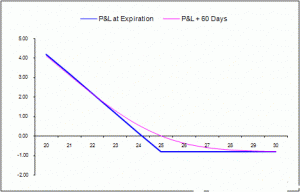A put option (usually just called a “put”) is a financial contract between two parties, the writer (seller) and the buyer of the option. The buyer acquires a short position with the right, but not the obligation, to sell the underlying instrument at an agreed-upon price (the strike price). If the buyer exercises his right to sell the option, the seller is obliged to buy it at the strike price. In exchange for having this option, the buyer pays the writer a fee (the option premium).A long put can be an ideal tool for an investor who wishes to participate profitably from a downward price move in the underlying stock. Before moving into more complex bearish strategies, an investor should thoroughly understand the fundamentals about buying and holding put options.
Risk vs. Reward
Maximum Profit: Limited Only by Stock Declining to Zero
Maximum Loss: Limited Premium Paid
Upside Profit at Expiration: Strike Price – Stock Price at Expiration – Premium Paid
Assuming Stock Price Below BEP
The maximum profit amount can be limited by the stock’s potential decrease to no less than zero. At expiration an in-the-money put will generally be worth its intrinsic value. Though the potential loss is predetermined and limited in dollar amount, it can be as much as 100% of the premium initially paid for the put. Whatever your motivation for purchasing the put, weigh the potential reward against the potential loss of the entire premium paid.
